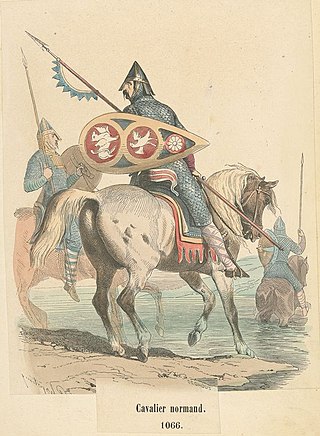
Year 1011 (MXI) was a common year starting on Monday of the Julian Calendar.
The 1010s was a decade of the Julian Calendar which began on January 1, 1010, and ended on December 31, 1019.
Year 1020 (MXX) was a leap year starting on Friday of the Julian calendar.

The Catepanateof Italy was a province of the Byzantine Empire from 965 until 1071. At its greatest extent, it comprised mainland Italy south of a line drawn from Monte Gargano to the Gulf of Salerno. North of that line, Amalfi and Naples also maintained allegiance to Constantinople through the catepan. The Italian region of Capitanata derives its name from katepanikion.
Argyrus was a Lombard nobleman and Byzantine general, son of the Lombard hero Melus. He was born in Bari.
Rainulf Drengot was a Norman adventurer and mercenary in southern Italy. In 1030 he became the first count of Aversa. He was a member of the Drengot family.

Pandulf IV was the Prince of Capua on three separate occasions.

Melus was a Lombard nobleman from the Apulian town of Bari, whose ambition to carve for himself an autonomous territory from the Byzantine catapanate of Italy in the early eleventh century inadvertently sparked the Norman presence in Southern Italy. He was the first Duke of Apulia.

Basil Boioannes, in Italian called Bugiano, was the Byzantine catapan of Italy and one of the greatest Byzantine generals of his time. His accomplishments enabled the Empire to reestablish itself as a major force in southern Italy after centuries of decline. Yet, the Norman adventurers introduced into the power structure of the Mezzogiorno would be the eventual beneficiaries.
Guaimar III was the Lombard prince of Salerno from around 994 to his death. Under his reign, Salerno entered an era of great splendour. Opulenta Salernum was the inscription on his coins. He made Amalfi, Gaeta and Sorrento his vassals and annexed much of Byzantine Apulia and Calabria.
The Battle of Cannae took place in 1018 between the Byzantines under the Catepan of Italy Basil Boioannes and the Lombards under Melus of Bari. The Lombards had also hired some Norman cavalry mercenaries under their leader Gilbert Buatère, while Boioannes had a detachment of elite Varangian Guard sent to him at his request to combat the Normans. The engagement was one of the first clashes between the Byzantines of southern Italy and the Normans.
Richard Drengot was the count of Aversa (1049–1078), prince of Capua and duke of Gaeta (1064–1078).
Atenulf was the son of Prince Landulf V of Benevento and brother of Prince Pandulf III. In 1040, Benevento still had the prestige of being the first of the independent Lombard principalities of the Mezzogiorno. So, when the Lombard Arduin, topoterites of Melfi, and his Norman mercenaries rebelled against Byzantine authority, they elected the brother of Pandulf as their leader, calling him "prince of Benevento."
Basil Mesardonites was the Catapan of Italy, representing the Byzantine Emperor there, from 1010 to 1016 or 1017. He succeeded the catapan John Kourkouas, who died fighting the Lombards, then in rebellion under Melus, early in 1010. In March, Basil disembarked with reinforcements from Constantinople and Leo Tornikios Kontoleon, the strategos of Cephalonia. Basil immediately besieged the rebels in Bari. The Greek citizens of the city negotiated with Basil and forced the Lombard leaders, Melus and Dattus, to flee. Basil entered the city on June 11, 1011 and reestablished Byzantine authority. He did not follow his victory up with any severe reactions. He simply sent the family of Melus, including his son Argyrus, to Constantinople. Basil's next move was to ally to the Roman Empire as many Lombard principalities as possible. He visited Salerno in October, where Prince Guaimar III was nominally a Byzantine vassal. He then moved on to Monte Cassino, which monastery was sheltering Dattus on its lands. Basil nevertheless confirmed all the privileges of the monastery over its property in Greek territory. The abbot, Atenulf, was a brother of the prince of Capua, Pandulf IV. The monastery then promptly expelled Dattus and he fled to papal territory. Basil held the Greek catapanate in peace until his death in 1016, or, according to Lupus Protospatharius, 1017. He was replaced by the aforementioned strategos of Cephalonia, Leo.
The Drengots were a Norman family of mercenaries, one of the first to head to Southern Italy to fight in the service of the Lombards. They became the most prominent family after the Hautevilles.

The Norman conquest of southern Italy lasted from 999 to 1194, involving many battles and independent conquerors.

The Battle of Olivento was fought on 17 March 1041 between the Byzantine Empire and the Normans of southern Italy and their Lombard allies near the Olivento river, between the actual Basilicata and Apulia, southern Italy.
Atenulf was the Abbot of Montecassino from 1011 until his death. He was a cousin of Prince Pandulf II of Capua, a younger son of Prince Pandulf III and brother of Prince Pandulf IV.
Abulchares was a Byzantine general of Arab origin who served as the catepan of Italy from 1064 until his death. The chief sources for his catapanate are Skylitzes Continuatus and Anonymi Barensis Chronicon. Skylitzes Continuatus records that Abulchares was also duke (doux) of Dyrrhachium across the Adriatic, but this is chronologically impossible, since Perenos is recorded as duke at this time.

Helena, born Olympias, was a daughter of the Norman duke of Apulia, Robert Guiscard, and the Lombard noblewoman Sikelgaita. From 1074 until 1078, she was the fiancée of the Byzantine co-emperor Constantine Doukas.